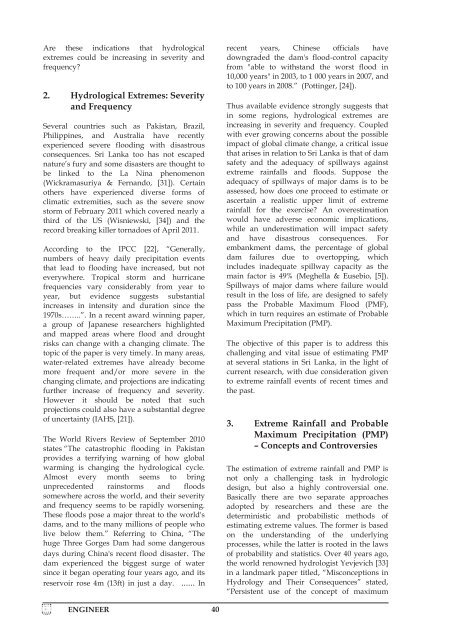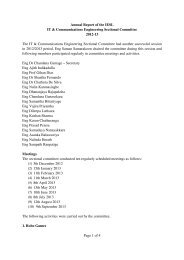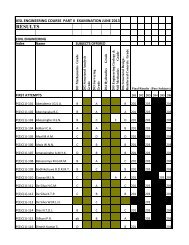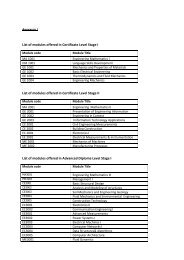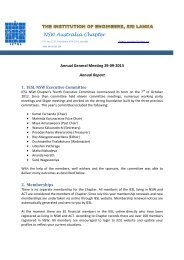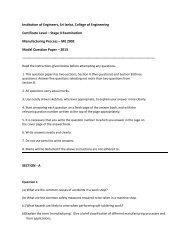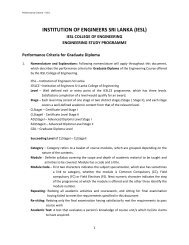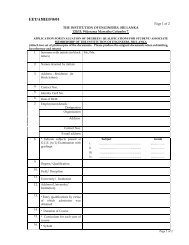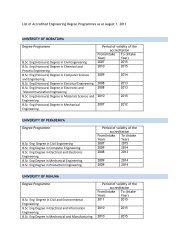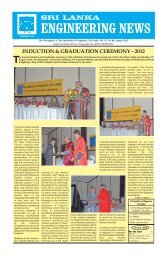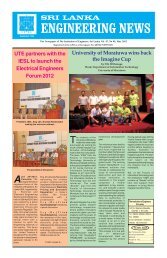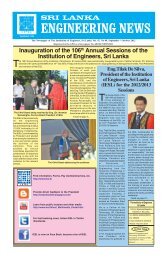Download - The Institution of Engineers, Sri Lanka
Download - The Institution of Engineers, Sri Lanka
Download - The Institution of Engineers, Sri Lanka
Create successful ePaper yourself
Turn your PDF publications into a flip-book with our unique Google optimized e-Paper software.
Are these indications that hydrological<br />
extremes could be increasing in severity and<br />
frequency?<br />
2. Hydrological Extremes: Severity<br />
and Frequency<br />
Several countries such as Pakistan, Brazil,<br />
Philippines, and Australia have recently<br />
experienced severe flooding with disastrous<br />
consequences. <strong>Sri</strong> <strong>Lanka</strong> too has not escaped<br />
nature’s fury and some disasters are thought to<br />
be linked to the La Nina phenomenon<br />
(Wickramasuriya & Fernando, [31]). Certain<br />
others have experienced diverse forms <strong>of</strong><br />
climatic extremities, such as the severe snow<br />
storm <strong>of</strong> February 2011 which covered nearly a<br />
third <strong>of</strong> the US (Wisniewski, [34]) and the<br />
record breaking killer tornadoes <strong>of</strong> April 2011.<br />
According to the IPCC [22], “Generally,<br />
numbers <strong>of</strong> heavy daily precipitation events<br />
that lead to flooding have increased, but not<br />
everywhere. Tropical storm and hurricane<br />
frequencies vary considerably from year to<br />
year, but evidence suggests substantial<br />
increases in intensity and duration since the<br />
1970s……..”. In a recent award winning paper,<br />
a group <strong>of</strong> Japanese researchers highlighted<br />
and mapped areas where flood and drought<br />
risks can change with a changing climate. <strong>The</strong><br />
topic <strong>of</strong> the paper is very timely. In many areas,<br />
water-related extremes have already become<br />
more frequent and/or more severe in the<br />
changing climate, and projections are indicating<br />
further increase <strong>of</strong> frequency and severity.<br />
However it should be noted that such<br />
projections could also have a substantial degree<br />
<strong>of</strong> uncertainty (IAHS, [21]).<br />
<strong>The</strong> World Rivers Review <strong>of</strong> September 2010<br />
states “<strong>The</strong> catastrophic flooding in Pakistan<br />
provides a terrifying warning <strong>of</strong> how global<br />
warming is changing the hydrological cycle.<br />
Almost every month seems to bring<br />
unprecedented rainstorms and floods<br />
somewhere across the world, and their severity<br />
and frequency seems to be rapidly worsening.<br />
<strong>The</strong>se floods pose a major threat to the world's<br />
dams, and to the many millions <strong>of</strong> people who<br />
live below them.” Referring to China, “<strong>The</strong><br />
huge Three Gorges Dam had some dangerous<br />
days during China's recent flood disaster. <strong>The</strong><br />
dam experienced the biggest surge <strong>of</strong> water<br />
since it began operating four years ago, and its<br />
reservoir rose 4m (13ft) in just a day. ...... In<br />
ENGINEER 40 2<br />
recent years, Chinese <strong>of</strong>ficials have<br />
downgraded the dam's flood-control capacity<br />
from "able to withstand the worst flood in<br />
10,000 years" in 2003, to 1 000 years in 2007, and<br />
to 100 years in 2008.” (Pottinger, [24]).<br />
Thus available evidence strongly suggests that<br />
in some regions, hydrological extremes are<br />
increasing in severity and frequency. Coupled<br />
with ever growing concerns about the possible<br />
impact <strong>of</strong> global climate change, a critical issue<br />
that arises in relation to <strong>Sri</strong> <strong>Lanka</strong> is that <strong>of</strong> dam<br />
safety and the adequacy <strong>of</strong> spillways against<br />
extreme rainfalls and floods. Suppose the<br />
adequacy <strong>of</strong> spillways <strong>of</strong> major dams is to be<br />
assessed, how does one proceed to estimate or<br />
ascertain a realistic upper limit <strong>of</strong> extreme<br />
rainfall for the exercise? An overestimation<br />
would have adverse economic implications,<br />
while an underestimation will impact safety<br />
and have disastrous consequences. For<br />
embankment dams, the percentage <strong>of</strong> global<br />
dam failures due to overtopping, which<br />
includes inadequate spillway capacity as the<br />
main factor is 49% (Meghella & Eusebio, [5]).<br />
Spillways <strong>of</strong> major dams where failure would<br />
result in the loss <strong>of</strong> life, are designed to safely<br />
pass the Probable Maximum Flood (PMF),<br />
which in turn requires an estimate <strong>of</strong> Probable<br />
Maximum Precipitation (PMP).<br />
<strong>The</strong> objective <strong>of</strong> this paper is to address this<br />
challenging and vital issue <strong>of</strong> estimating PMP<br />
at several stations in <strong>Sri</strong> <strong>Lanka</strong>, in the light <strong>of</strong><br />
current research, with due consideration given<br />
to extreme rainfall events <strong>of</strong> recent times and<br />
the past.<br />
3. Extreme Rainfall and Probable<br />
Maximum Precipitation (PMP)<br />
– Concepts and Controversies<br />
<strong>The</strong> estimation <strong>of</strong> extreme rainfall and PMP is<br />
not only a challenging task in hydrologic<br />
design, but also a highly controversial one.<br />
Basically there are two separate approaches<br />
adopted by researchers and these are the<br />
deterministic and probabilistic methods <strong>of</strong><br />
estimating extreme values. <strong>The</strong> former is based<br />
on the understanding <strong>of</strong> the underlying<br />
processes, while the latter is rooted in the laws<br />
<strong>of</strong> probability and statistics. Over 40 years ago,<br />
the world renowned hydrologist Yevjevich [33]<br />
in a landmark paper titled, “Misconceptions in<br />
Hydrology and <strong>The</strong>ir Consequences” stated,<br />
“Persistent use <strong>of</strong> the concept <strong>of</strong> maximum


